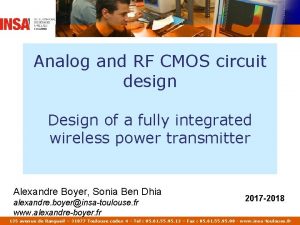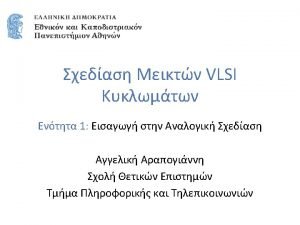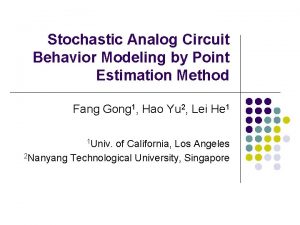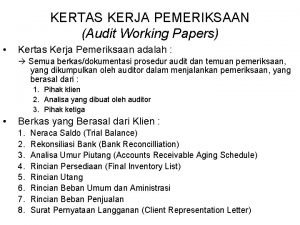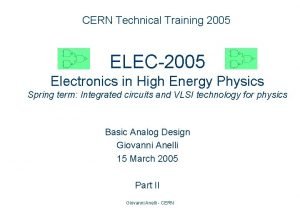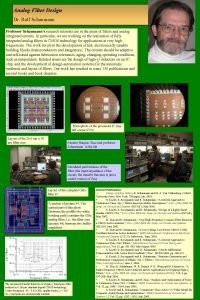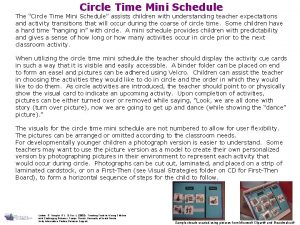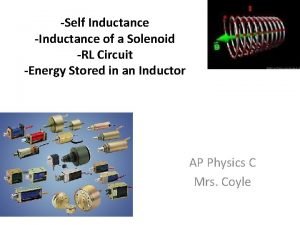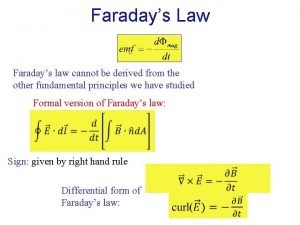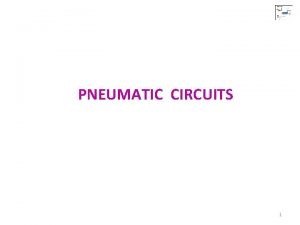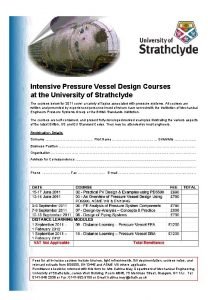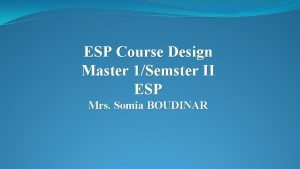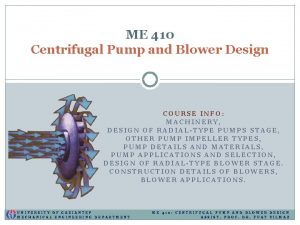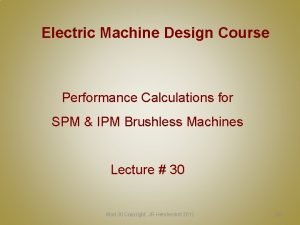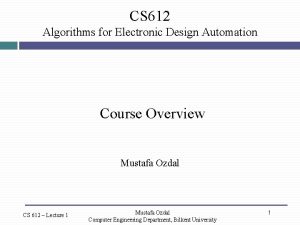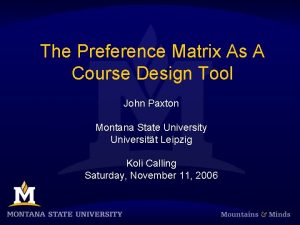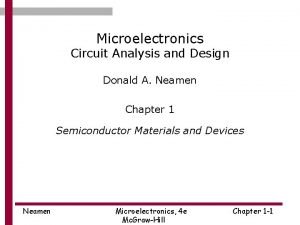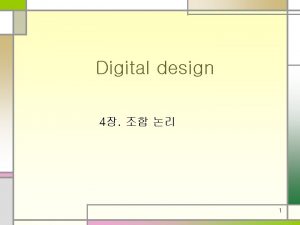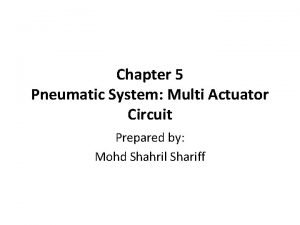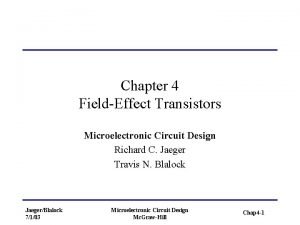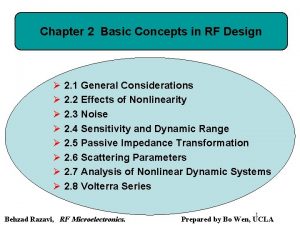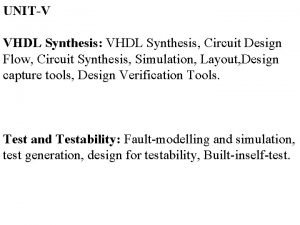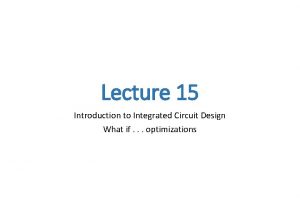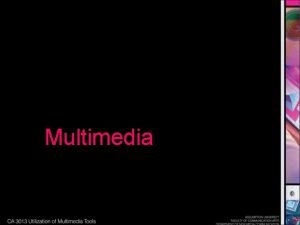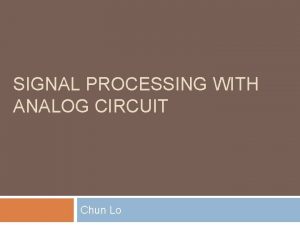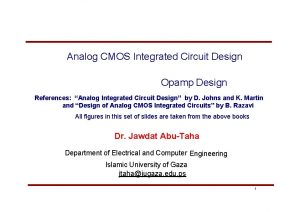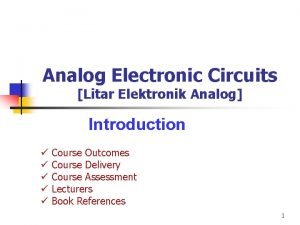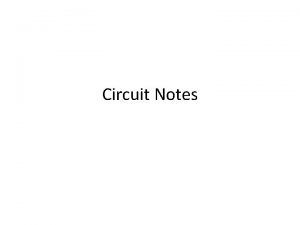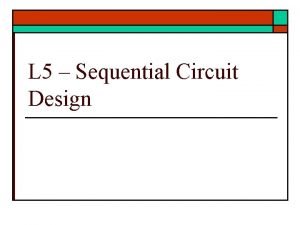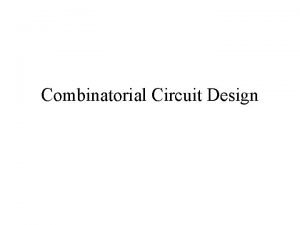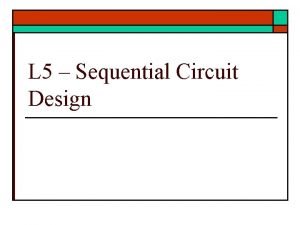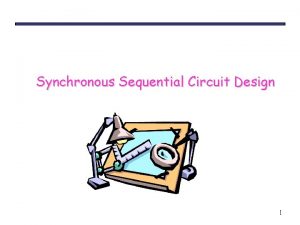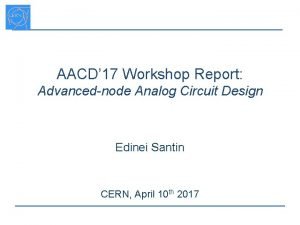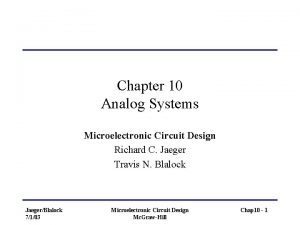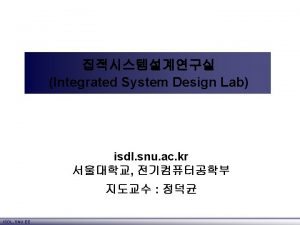Course Analog Circuit Design Time schedule Mo 11



















































![INTEGRATED CAPACITORS: LAYOUT 3 Matching: capacitors with not-integer ratio [C 2/C 1] -1 squared INTEGRATED CAPACITORS: LAYOUT 3 Matching: capacitors with not-integer ratio [C 2/C 1] -1 squared](https://slidetodoc.com/presentation_image_h/e816f4d35cc4f15242518d00c087c5a0/image-52.jpg)

- Slides: 53

Course: Analog Circuit Design Time schedule: Mo 11. 00 -13. 00 We 11. 00 -13. 00 Th 14. 00 -16. 00 Office hours: Mo 16. 00 -18. 00 Exams: Feb. (2), Jun. -Jul. (2), Sep. (2) Oral examination Additional course material: ftp: //ftp. dii. unisi. it/pub/users/vignoli/Analog_Circuit_Design Please, register at the following link: goo. gl/k. JXGzy

Course: Analog Circuit Design Time schedule: Mo 11. 00 -13. 00 11. 30 -13. 00 We 11. 00 -13. 00 11. 30 -13. 00 Th 14. 00 -16. 00 14. 30 -16. 00 Office hours: Mo 16. 00 -18. 00 Exams: Feb. (2), Jun. -Jul. (2), Sep. (2) Oral examination Additional course material: ftp: //ftp. dii. unisi. it/pub/users/vignoli/Analog_Circuit_Design Please, register at the following link: goo. gl/k. JXGzy

References: F. Maloberti Analog Design for CMOS VLSI Systems Kluwer 2001 J. Millman, C. Halkias Integrated Electronics: Analog and Digital Circuit and Systems Mc. Graw-Hill 1972 A. Sedra, K. Smith Microelectronic Circuits (7 th edition) Oxford University Press 2014 P. Gray, R Meyer Analysis and Design of Analog Integrated Circuits (3 rd ed. ) Wiley 1993 M. S. Tyagi Introduction to Semiconductor Material and Devices Wiley 1991




MATERIALS: electric behavior semiconductor Insulator conductor

SEMICONDUCTORS: electric behavior Fermi-Dirac distribution: occupation probability for the energy level E In semiconductors EF is in the Band-Gap

Intrinsic Semiconductors: free carriers where Ne(E) is Energetic State Density function in the material. NC is the number of available states (per cm-3) in the conduction band

DOPING ACCEPTOR DONOR EF n-type The Fermi energy moves with doping T effect EF p-type



PHOTOLITOGRAPHY Photoresist spin. -coating EXPOSITION: The mask is transferred to the photoresist Thick film: 1 mm Uv - X-ray

• The photoresist chemically reacts and dissolves in the developing solution, only on the parts that were not masked during exposure (positive method). • Development is performed with an alkaline developing solution. • After the development, photoresist is left on the wafer surface in the shape of the mask pattern. Masked photoresist solvents remove exposed (unexposed) resist Etching removes material from wafer surface where resist has been removed

Dry etching Wet etching



Also PVD

Materials: Si substrate • Monocrystalline silicon is produced from purified polycrystalline silicon by “pulling” an ingot – polysilicon is melted using radio frequency induction heaters – “seed crystal” of monocrystalline silicon is dipped into melt – silicon grows around structure of seed as seed is slowly withdrawn • Sawed into wafers about 600 microns thick – only a few microns are actually used for IC devices – then etched, polished, and cleaned – stacked in carriers


Materials • Single crystal silicon – SCS – Anisotropic crystal – Semiconductor, great heat conductor • Silicon dioxide is created by interaction between silicon and oxygen or water vapor – – Si + O 2 = Si. O 2 or Si + 2 H 2 O = Si. O 2 + 2 H 2 Excellent thermal and electrical insulator protects surface from contaminants forms insulating layer between conductors – forms barrier to dopants during diffusion or ion implantation – grows above and into silicon surface – Thermal oxide, LTO, PSG: different names for different deposition conditions and methods • Polycrystalline silicon – polysilicon – – – Mostly isotropic material Semiconductor also a conductor, but with much more resistance than metal or diffused layers created when silicon is epitaxially grown on Si. O 2 commonly used (heavily doped) for gate connections in most MOS processes • Silicon nitride – Si 3 N 4 – Excellent electrical insulator • Aluminum – Al – Metal – excellent thermal and electrical conductor

EFFECT OF FLATBAND VOLTAGE VFB (VFB < 0)

VGB = 0

SUBSTRATE P-type Si OXIDE Si. O 2 GATE Polisilicon SUBSTRATE CONTACT Polisilicon VGB VOX -VFB - - + Space charge regions -t. OX 0 x. D x Potential VGB-VFB VOX Φs(0) -t. OX x

STRONG INVERSION CONDITION


SMALL SIGNAL EQUIVALENT CIRCUIT OF A MOS TRANSISTOR

MOS TRANSISTOR LAYOUT • SOURCE AND DRAIN PARASITIC RESISTANCES • SOURCE AND DRAIN PARASITIC CAPACITANCES • MATCHING

SOURCE AND DRAIN PARASITIC RESISTANCES

SOURCE AND DRAIN PARASITIC CAPACITANCES

MATCHING You must avoid: D Use always the same MOS orientation in your layout: silicon is anisotropic S S D

MATCHING 1 2 3

MATCHING 1 2 3

MATCHING

DESIGN RULES Geometrical recommendations due to the limited accuracy of the technology (mask alignment, lateral diffusion, etching undercut, optical resolution…) Design Kit: design rules + Spice models and technology features

INTEGRATED RESISTORS 1

INTEGRATED RESISTORS 2 DIFFERENT SOLUTIONS (a)

INTEGRATED RESISTORS 3 DIFFERENT SOLUTIONS (b) POLYSILICON RESISTORS • Lower coupling with substrate • Up to two shieldings • Top shielding (from noisy metal lines, package coupling…. )

INTEGRATED RESISTORS 3

INTEGRATED RESISTORS 4 FACTORS AFFECTING ACCURACY • Poor absolute accuracy (20 -40% - large parameter drift) • Good matching (ratio) accuracy (0. 1 -0. 2% - it depends on local parameter variations)

INTEGRATED RESISTORS 5 Design Guidelines (a)

INTEGRATED RESISTORS 6 Design Guidelines (b)

INTEGRATED RESISTORS 7 Design Guidelines (c)

INTEGRATED CAPACITORS 1

INTEGRATED CAPACITORS 2

INTEGRATED CAPACITORS 3 COX tox ≤ 10 nm εr(Si. O 2)=3. 8 COX ~ 3. 36 f. F/μm 2

INTEGRATED CAPACITORS 4

INTEGRATED CAPACITORS 5

INTEGRATED CAPACITORS 6 A’ = W’L’ WL – 2 (L+W)Δx = A – P Δx = A (1 - Δx P/A) • The relative reduction of A remains constant, given Δx, if the ratio P/A is constant (matched elements) • The fringe effect reduces the capacitance at the plate boundary proportionally to tox P/A -> (L, W >> tox) • Effect of the thick oxides at the plate boundary

INTEGRATED CAPACITORS: LAYOUT 1 Layout examples for poly 1 -poly 2 capacitors

INTEGRATED CAPACITORS: LAYOUT 2 Matching: capacitors with integer ratio Shielding (well)
![INTEGRATED CAPACITORS LAYOUT 3 Matching capacitors with notinteger ratio C 2C 1 1 squared INTEGRATED CAPACITORS: LAYOUT 3 Matching: capacitors with not-integer ratio [C 2/C 1] -1 squared](https://slidetodoc.com/presentation_image_h/e816f4d35cc4f15242518d00c087c5a0/image-52.jpg)
INTEGRATED CAPACITORS: LAYOUT 3 Matching: capacitors with not-integer ratio [C 2/C 1] -1 squared capacitors with area C 1 = L 2 1 rectangular capacitor with area [C 2/C 1] 1) C 1 Ck= Wk Lk = (C 2/C 1 - + All the capacitors with constant P/A L 2/4 L=L/4=Lk. Wk/2(Lk + Wk) Ck/C 1=Lk. Wk/L 2

PASSIVE COMPONENTS: CAPACITORS – Design Guidelines
 Device modeling for analog and rf cmos circuit design
Device modeling for analog and rf cmos circuit design Razavi cmos analog circuit design
Razavi cmos analog circuit design Analog circuit behavior
Analog circuit behavior Contoh working paper audit
Contoh working paper audit How to write analogue time
How to write analogue time Titwala vipassana centre
Titwala vipassana centre Nus soc course schedule
Nus soc course schedule Virtuoso analog design environment user guide
Virtuoso analog design environment user guide Elec2005
Elec2005 Design of analog filters schaumann
Design of analog filters schaumann English bond t junction
English bond t junction Course number and title
Course number and title Course interne moyenne externe
Course interne moyenne externe For minutes. start.
For minutes. start. Series circuit disadvantages
Series circuit disadvantages Type of circuits
Type of circuits Phet circuit construction kit
Phet circuit construction kit Series vs parallel
Series vs parallel Incomplete circuit
Incomplete circuit Short circuit example
Short circuit example Venn diagram series and parallel circuits
Venn diagram series and parallel circuits Blood circulation system diagram
Blood circulation system diagram Advantages of parallel circuits over series circuit
Advantages of parallel circuits over series circuit Elements of research
Elements of research Background of the study
Background of the study Denise garcia vilte
Denise garcia vilte Time schedule phd proposal
Time schedule phd proposal General observation schedule pe
General observation schedule pe Circle time visual schedule
Circle time visual schedule Tamucc workday
Tamucc workday Time constant of rc circuit
Time constant of rc circuit Energy in a solenoid
Energy in a solenoid Curly electric field
Curly electric field Circuit diagram pneumatic system
Circuit diagram pneumatic system Rfic course
Rfic course Pressure vessel design course
Pressure vessel design course Course design in esp
Course design in esp Bldc motor design course
Bldc motor design course Generator vs motor
Generator vs motor Pump design course
Pump design course Spm design course
Spm design course Electric machine design coaching
Electric machine design coaching Electronic design automation course
Electronic design automation course Course planning and syllabus design
Course planning and syllabus design Preference matrix
Preference matrix Background design course
Background design course English for specific purposes course design
English for specific purposes course design Diode load line
Diode load line Binary full subtractor
Binary full subtractor Explain the step displacement diagram for a+b+b-a- sequence
Explain the step displacement diagram for a+b+b-a- sequence Jaeger microelectronic circuit design download
Jaeger microelectronic circuit design download Rf circuit design ppt
Rf circuit design ppt Design flow of vlsi system
Design flow of vlsi system Por circuit design
Por circuit design
